LOCALIZER: Subcellular localization prediction of both plant and effector proteins in the plant cell
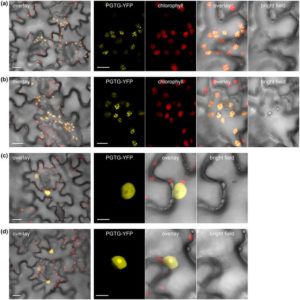 Proteins carry sequence tags that are read by cellular machineries that deliver the proteins to their proper destinations, which include the nucleus, mitochondria and plastid. Many pathogen effector proteins have acquired such targeting tags too, but for these can sometimes be cryptic to bioinformatics tools trained on native plant proteins. Sperschneider et al. have developed a tool with an improved ability to identify effector protein localization tags (it does pretty well with plant proteins too). The tool, called LOCALIZER, can be found at http://localizer.csiro.au/. Sci. Reports 10.1038/srep44598
Proteins carry sequence tags that are read by cellular machineries that deliver the proteins to their proper destinations, which include the nucleus, mitochondria and plastid. Many pathogen effector proteins have acquired such targeting tags too, but for these can sometimes be cryptic to bioinformatics tools trained on native plant proteins. Sperschneider et al. have developed a tool with an improved ability to identify effector protein localization tags (it does pretty well with plant proteins too). The tool, called LOCALIZER, can be found at http://localizer.csiro.au/. Sci. Reports 10.1038/srep44598


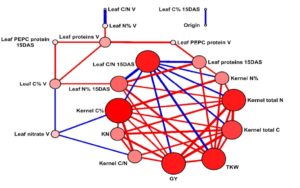 The path from genome to phenome is difficult to predict. Cañas et al. tried to identify biochemical markers that are correlated with kernel yield that could be selected for in breeding. Specifically, they collected data from metabolomics, enzyme activity assays and metabolic modeling, taken during the vegetative phase and the grain filling state 15 days after silking (15 DAS), from 19 maize lines. Interestingly, in this sample pool representing broad genetic distance, they observed “only a slight relationship between the genetic distance of the 19 lines and their enzyme activities 15 DAS”. A strong correlation between grain yield and kernel C and N was observed, and higher levels of enzymes involved in C4 photosynthesis and nitrogen assimilation into amino acids during vegetative growth was also a positive indicator of yield. Plant Cell
The path from genome to phenome is difficult to predict. Cañas et al. tried to identify biochemical markers that are correlated with kernel yield that could be selected for in breeding. Specifically, they collected data from metabolomics, enzyme activity assays and metabolic modeling, taken during the vegetative phase and the grain filling state 15 days after silking (15 DAS), from 19 maize lines. Interestingly, in this sample pool representing broad genetic distance, they observed “only a slight relationship between the genetic distance of the 19 lines and their enzyme activities 15 DAS”. A strong correlation between grain yield and kernel C and N was observed, and higher levels of enzymes involved in C4 photosynthesis and nitrogen assimilation into amino acids during vegetative growth was also a positive indicator of yield. Plant Cell  Circular RNAs (circRNAs) are a recently discovered form of stable, covalently-closed RNA found in all domains of eukaryotic life. The origins and functions of circRNAs have been under intensive investigation. Often, circRNAs consist of one or more exons, often corresponding to skipped exons from genes that are alternatively spliced (AS), but the relationship between circRNA and AS has been unclear. Conn et al. started with 12 abundant Arabidopsis circRNAs which they matched to their cognate genes, 11 of which showed exon skipping. They then focused on genes where the AS variant was known to have biological function. When they highly expressed a circRNA corresponding to exon 6 of SEP3, the resulting plants showed an increase in the exon 6-skipped AS variant, and a decrease in sepal number. The authors showed hybridization between the circRNA and the corresponding gene, and suggest that this interaction promotes the recruitment of splicing factors and the production of the AS variant. Nature Plants
Circular RNAs (circRNAs) are a recently discovered form of stable, covalently-closed RNA found in all domains of eukaryotic life. The origins and functions of circRNAs have been under intensive investigation. Often, circRNAs consist of one or more exons, often corresponding to skipped exons from genes that are alternatively spliced (AS), but the relationship between circRNA and AS has been unclear. Conn et al. started with 12 abundant Arabidopsis circRNAs which they matched to their cognate genes, 11 of which showed exon skipping. They then focused on genes where the AS variant was known to have biological function. When they highly expressed a circRNA corresponding to exon 6 of SEP3, the resulting plants showed an increase in the exon 6-skipped AS variant, and a decrease in sepal number. The authors showed hybridization between the circRNA and the corresponding gene, and suggest that this interaction promotes the recruitment of splicing factors and the production of the AS variant. Nature Plants 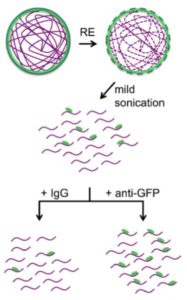 Chromatin in the nucleus is not randomly arranged. In animal cells, studies have identified an enrichment for non-genic or silenced DNA near the nuclear envelope, as demonstrated by its association with the nuclear lamin proteins. Plants don’t have proteins like animal lamins, but a few envelope-associated proteins have been identified. Bi et al. used a modified chromatin-immunoprecipitation method to identify genomic regions associated with a protein that accumulates at the nuclear envelope, NUP1 (fused to GFP). The authors found that, similar to findings from animal cells, the nuclear periphery is enriched for repressed chromatin, although there are some interesting and notable exceptions. Genome Bio.
Chromatin in the nucleus is not randomly arranged. In animal cells, studies have identified an enrichment for non-genic or silenced DNA near the nuclear envelope, as demonstrated by its association with the nuclear lamin proteins. Plants don’t have proteins like animal lamins, but a few envelope-associated proteins have been identified. Bi et al. used a modified chromatin-immunoprecipitation method to identify genomic regions associated with a protein that accumulates at the nuclear envelope, NUP1 (fused to GFP). The authors found that, similar to findings from animal cells, the nuclear periphery is enriched for repressed chromatin, although there are some interesting and notable exceptions. Genome Bio. 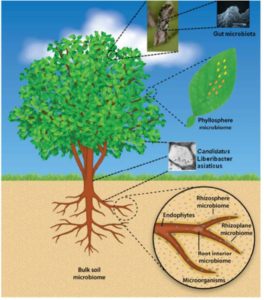 Huanglongbing (HLB or Citrus Greening Disease) has caused enormous economic losses in major citrus production areas, including Florida. The Huanglongbing disease pyramid consists of the bacteria Liberibacters, citrus psyllid vectors (insects), citrus hosts, and the environment in which they all exist. The authors complement existing reviews of Liberibacters and citrus plant interactions by reviewing the literature on Liberibacter/psyllid interaction, psyllid/plant interaction, and on the citrus microbiome component of this pyramid. This review highlights changes in proportions and amounts of microbial species in the rhizosphere, rhizoplane, endosphere, and phyllosphere when citrus becomes infected with HLB. Reviewing what is known of the complexity of the HLB disease pyramid bolsters the argument that successful management strategies must take this complex web of reciprocal interactions into account. (Summary by
Huanglongbing (HLB or Citrus Greening Disease) has caused enormous economic losses in major citrus production areas, including Florida. The Huanglongbing disease pyramid consists of the bacteria Liberibacters, citrus psyllid vectors (insects), citrus hosts, and the environment in which they all exist. The authors complement existing reviews of Liberibacters and citrus plant interactions by reviewing the literature on Liberibacter/psyllid interaction, psyllid/plant interaction, and on the citrus microbiome component of this pyramid. This review highlights changes in proportions and amounts of microbial species in the rhizosphere, rhizoplane, endosphere, and phyllosphere when citrus becomes infected with HLB. Reviewing what is known of the complexity of the HLB disease pyramid bolsters the argument that successful management strategies must take this complex web of reciprocal interactions into account. (Summary by 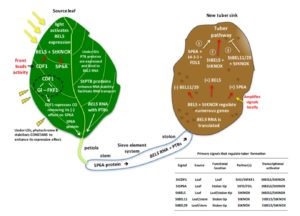 Potato is an important food crop, but unlike most of the other major foods, it is a tuber, not a seed. Classic studies showed that there is a mobile, photoperiod-induced signal that moves from the shoot to the stolen tip (an underground, stem-like structure) to initiate tuberization. Experimental studies point to three factors as key in the onset of tuberization. Hannapel et al. review recent evidence for these tuberization signals. StSP6A (an orthologue of “florigen”, FLOWERING LOCUS T) is a phloem-mobile protein produced in the leaf under favorable conditions. StCDF1 functions in the leaf to enhance expression of StSP6A. BEL5 moves as a phloem-mobile RNA from leaf to stolon, where it is translated and serves as a transcription factor. This review also discusses factors upstream and downstream of these three key factors, and unresolved issues. Plant Physiol.
Potato is an important food crop, but unlike most of the other major foods, it is a tuber, not a seed. Classic studies showed that there is a mobile, photoperiod-induced signal that moves from the shoot to the stolen tip (an underground, stem-like structure) to initiate tuberization. Experimental studies point to three factors as key in the onset of tuberization. Hannapel et al. review recent evidence for these tuberization signals. StSP6A (an orthologue of “florigen”, FLOWERING LOCUS T) is a phloem-mobile protein produced in the leaf under favorable conditions. StCDF1 functions in the leaf to enhance expression of StSP6A. BEL5 moves as a phloem-mobile RNA from leaf to stolon, where it is translated and serves as a transcription factor. This review also discusses factors upstream and downstream of these three key factors, and unresolved issues. Plant Physiol. 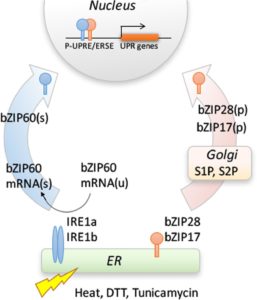 The unfolded protein response (UPR) is a eukaryote-wide signalling pathway in which unfolded proteins in the ER (often caused by abiotic stress) initiate signals transduced to the nucleus that lead to the expression of stress-response genes. Bao and Howell review the UPR in plants. They describe two ways that signals can move from the ER to the nucleus; in one, alternative RNA splicing of a bZIP transcription factor leads to the protein accumulating in the nucleus, and in the other different bZIP transcription factors are released from the ER and relocated to the nucleus. The review also discusses evidence, mostly from analysis of mutants, of the role of the UPR in hormone biology (auxin and brassinosteroids), vegetative and reproductive growth (including heat stress effects on pollen), and responses to pathogens. Front. Plant Sci.
The unfolded protein response (UPR) is a eukaryote-wide signalling pathway in which unfolded proteins in the ER (often caused by abiotic stress) initiate signals transduced to the nucleus that lead to the expression of stress-response genes. Bao and Howell review the UPR in plants. They describe two ways that signals can move from the ER to the nucleus; in one, alternative RNA splicing of a bZIP transcription factor leads to the protein accumulating in the nucleus, and in the other different bZIP transcription factors are released from the ER and relocated to the nucleus. The review also discusses evidence, mostly from analysis of mutants, of the role of the UPR in hormone biology (auxin and brassinosteroids), vegetative and reproductive growth (including heat stress effects on pollen), and responses to pathogens. Front. Plant Sci. 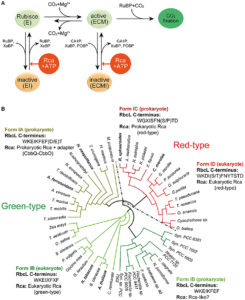 Rubisco, the fundamental enzyme required for photosynthetic carbon fixation, is susceptible to inactivation by the inhibitory binding of various metabolites. Rubisco activases (Rca’s) are enzymes that remodel Rubisco and facilitate the elimination of the inhibitor. All photosynthetic organisms have Rubisco activases that share a AAA+ domain. Bhat et al. review the structure and function of Rca enzymes found in prokaryotes and plants, and note that “the diversity of these enzymes provides a fascinating example of convergent evolution.” Front. Mol. Biosci.
Rubisco, the fundamental enzyme required for photosynthetic carbon fixation, is susceptible to inactivation by the inhibitory binding of various metabolites. Rubisco activases (Rca’s) are enzymes that remodel Rubisco and facilitate the elimination of the inhibitor. All photosynthetic organisms have Rubisco activases that share a AAA+ domain. Bhat et al. review the structure and function of Rca enzymes found in prokaryotes and plants, and note that “the diversity of these enzymes provides a fascinating example of convergent evolution.” Front. Mol. Biosci. 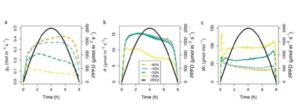 Stomatal control of transpiration is critical for maintaining important processes, such as plant water status, leaf temperature, as well as permitting sufficient CO2 diffusion into the leaf to maintain photosynthetic rates (A). Stomatal conductance (gs) often closely correlates with A and is thought to control the balance between water loss and carbon gain. It has been suggested that a mesophyll driven signal co-ordinates A and gs responses to maintain this relationship, however the signal has yet to be fully elucidated. Despite this correlation under stable environmental conditions, the responses of both parameters vary spatially and temporally and are dependent on species, environment and plant water status. Most current models neglect these aspects of gas exchange though it is clear they play a vital role in the balance of carbon fixation and water loss. Future efforts should consider the dynamic nature of whole plant gas exchange and how it represents much more than the sum of its individual leaf level components, as well as taking into consideration the long term effect on gas exchange over time.
Stomatal control of transpiration is critical for maintaining important processes, such as plant water status, leaf temperature, as well as permitting sufficient CO2 diffusion into the leaf to maintain photosynthetic rates (A). Stomatal conductance (gs) often closely correlates with A and is thought to control the balance between water loss and carbon gain. It has been suggested that a mesophyll driven signal co-ordinates A and gs responses to maintain this relationship, however the signal has yet to be fully elucidated. Despite this correlation under stable environmental conditions, the responses of both parameters vary spatially and temporally and are dependent on species, environment and plant water status. Most current models neglect these aspects of gas exchange though it is clear they play a vital role in the balance of carbon fixation and water loss. Future efforts should consider the dynamic nature of whole plant gas exchange and how it represents much more than the sum of its individual leaf level components, as well as taking into consideration the long term effect on gas exchange over time.